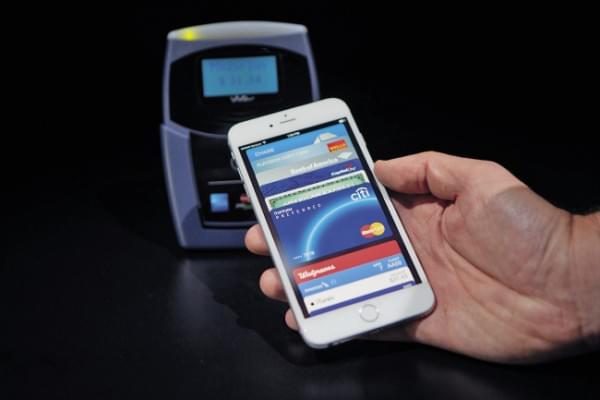Contactless payment
Apple Pay contactless payment was introduced at the right time. Last autumn Apple put its iPhone 6 and 6 plus models on the market. Together with them the company announced the launch of the Apple Watch too.
But the real surprise was Apple’s own payment system, Apple Pay. The contactless payment technology is a real novelty overseas because there traditional magnetic stripe cards are used widely. Basically Apple’s technology works like this: bank card data is stored on the phone in an application developed for this purpose. On the back of the device there is an NFC – Near Field Communication – chip and it is enough to hold it near the reader terminal, and then identify ourselves with our fingerprint to authorise the transaction. Apple made it clear that they don’t store bank card data on their own server. Apple signed contracts with many banks and card companies in the USA before launching the new service. By this spring Apple Pay may work with 90 percent of bank cards used in the United States. The company signed an agreement with many retail chains, petrol station chains, etc. for introducing the new technology. Timing was perfect because most US retailers will have to install new payment terminals before next autumn anyway, and installing one that can read NFC chips costs only a few dollars more. Competitors have already reacted to Apple’s move. For instance PayPal – purchased by eBay for USD 1.5 billion back in 2002 – announced that they are leaving eBay and continue as an independent company in the future. This spring at the 3GSM mobile expo in Barcelona Samsung announced that this summer they would launch their own payment system, called Samsung Pay. It will only work on Samsung Galaxy 6 smartphones, using NFC technology, but unlike Apple’s solution it will also work with payment terminals using magnetic stripe technology. Experts agree that Apple Pay needs some fine-tuning. The system won’t really spread until it can be used on Android devices too – but knowing Apple’s traditions this doesn’t seem likely. For retailers it is also an obstacle that they can’t connect the new payment technology with any loyalty programme, therefore they can’t learn about consumers’ habits and send them targeted offers. Not a simple mobile payment solution but an integrated mobile commerce application – this is what Simple is, according to Zsolt Nyéki, chief commercial and development officer at OTP Mobile, the application’s developer. Taxi can be ordered and paid for via Simple (they signed a deal with Főtaxi), parking tickets and motorways stickers can also be purchased. By using Simple’s party function users can browse the programmes of clubs and they can also use Simple to buy concert and cinema tickets, food or drinks. The app has been up and running since last December and it also works on Gear S, Samsung’s smartwatch which debuted in Hungary last December, too. Gábor Piller, the director of Samsung’s enterprise business told that they wanted the new product to feature as many apps as possible, so cooperating with Simple was a great opportunity. Another Hungarian company, SenseNet also developed a mobile payment system. Its name is Barion and just like PayPal it makes it possible to send money to someone via e-mail – if both parties have registered in the system. When we enter a store where Barion payment can be used, the option instantly appears on our smartphone. This form of payment isn’t NFC-based but uses the Bluetooth 4.0 technology. At the moment it can be used in 16 places in Hungary.
Related news
Related news
Technological advancements and business travel
The latest research from International Workplace Group (IWG), the leading…
Read more >K&H: a gift, but what and from which store?
When it comes to Christmas gift-giving, clothes are the most…
Read more >Eckes-Granini acquires fruit juice concentrate producer in Germany
Eckes-Granini, one of Europe’s leading juice producers, has acquired Wolfgang…
Read more >






